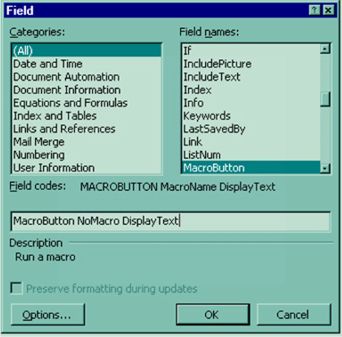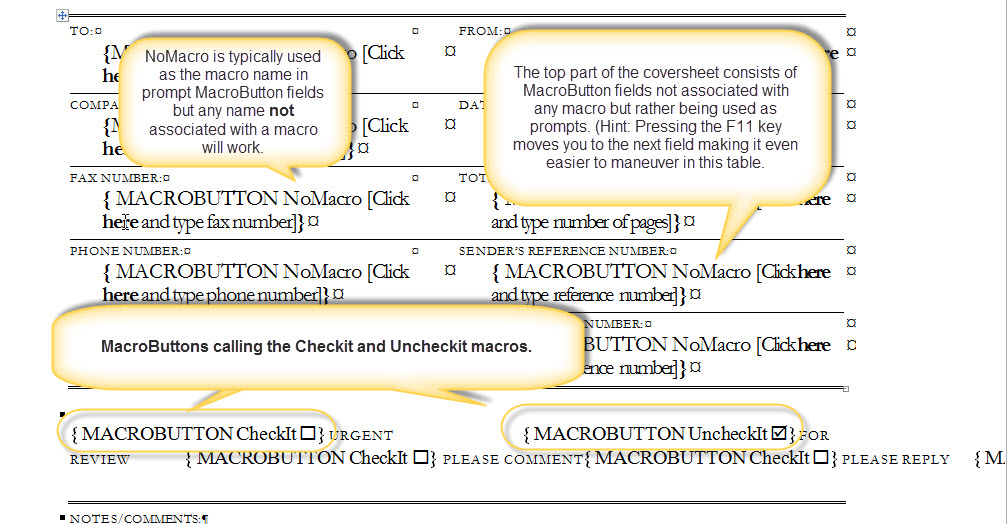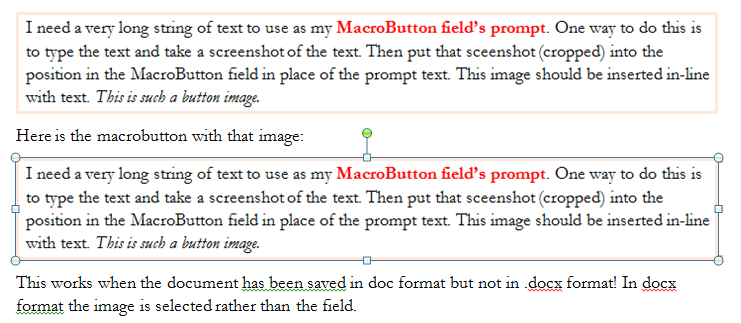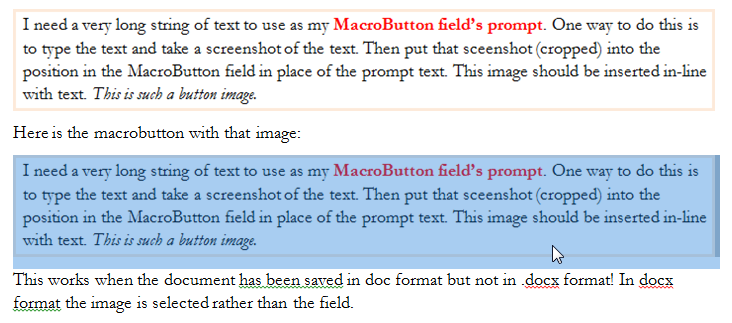MacroButton Field Tips and Tricks - not just for
macros
The MacroButton field is a field developed in early versions of Word
(pre-Windows). The name comes from the ability to trigger a macro. It
was early used to insert dummy text for typing and can still serve that
function well, without any macros. It continues to work, well, in Word
2019.
MacroButton Fields - Syntax and Behavior
Syntax
{ MacroButton MacroName DisplayText }
MacroButton - the field command
MacroName - name of macro being called - or
"NoMacro"
DisplayText - text that acts as the "button" for
the macro and is displayed in your document. Note that there are no
quotation marks used in this field. DisplayText can be any text you
want but will not wrap to a new line. There are limits on length. Instead of the DisplayText you can insert an
inline picture or icon to act
as a visual button for your macro. See
below, though for images. The text in a MacroButton field prompt
cannot be longer than a single line between the left and right
indents for the paragraph. You can shrink the font size of the
prompt text to fit more words on that single line.
Behavior
Clicking on a MacroButton field will select the field. Double-clicking
on one will activate a macro if there is a macro designated. You can change
this behavior to make the macro activate on a single click as well.
MacroButton Fields as Prompts
You can use the first behavior (selecting the field) to make simple
click-and-type prompts. If you look at many of the templates that come from Microsoft with Word,
you will find places that say something like "[Click here and
type]." If you click at that spot, the whole prompt is selected and
anything you type replaces it. Often, this is exactly what you want for
a simple prompt. What you are seeing is a simple implementation of the
"MacroButton" field.
This use of the macrobutton field is the forerunner of
Content Controls.
To insert a MacroButton field like this in your document type it then
make it a field.
As is the case with all fields, you cannot simply type the
field braces { }. You either have to use Word's Insert => Field
or press Ctrl+F9 and type the field contents. To get:
{ MacroButton NoMacro DisplayText }
you could simply type "MacroButton NoMacro
DisplayText" and select it.
Then press the Ctrl+F9 key combination to make it a field.
Pressing F9 will update it to the field display of
DisplayText. You must create or edit
the field manually to get colors or
other formatting in your prompt text that will disappear when the
user actually uses it and types.
Inserting a MacroButton field like this in your document using the Field
insertion dialog is a bit more involved:
(Word 97-2003)
Insert => Field ...
(Word 2007-2019) Insert => Quick Parts => Field ...

Where it says Field: type "MacroButton NoMacro prompt."
The "MacroButton" is the name of the field. "NoMacro"
is the name used by the field for the macro to be called - in this special case, none. The "prompt"
is whatever prompt text you want. This can be "[Click here and
type]" or the text that will usually be just fine but which the
user might want to change.
"NoMacro" is used as a convention to indicate that there is no macro
being used. Note that if there was an available macro with the name "nomacro"
that macro would be run by this field. Any name that does not
indicate an available macro will give the same result, that is, the
entire field will be selected when clicked on (as always happens with a
MacroButton) but since no macro can be found, the result is selected
text. If you want to format your prompt text, you need to do that by
revealing the field code and editing. To me, typing the field and then
using Ctrl+F9 to insert the braces is much easier.
As is the case with other fields, the F11 key will take you to the next field,
selecting that field. When you use macrobutton fields as prompts,
you may want to put an instruction in your documents to use F11 to go to
the next field. I do this putting the instruction in blue
or red text and a different font in a
textbox formatted to float in front of text. The textbox is formatted to
have no lines and no fill. The text in the textbox is formatted as hidden
so it should not print. I have this textbox as an AutoText entry in my
developer's template so that I can insert it easily when I prepare a new
template.
Below is an example of how a Macrobutton Prompt appears in a document.
(Screenshot) The field code for this prompt is:
{ MacroButton NoMacro This is a
macrobutton prompt!
When you click on it, all is selected. }
The first paragraph shows the prompt as displayed on the page. The second shows the prompt after
it has been clicked on before typing; the third shows that the prompt colors do not
show up in the text after the user types.

You can
download a
free Add-In that gives you a dialog box below to add a MacroButton
prompt to your document where you want with a choice of colors for the
prompt text.

Dialog box from
Add-In
MacroButton Fields to Run Macros
Instead of simply being a prompt for typing, this MacroButton field
will run a macro if double-clicked. (This can be altered to a single
click using VBA.) Instead of NoMacro, simply type the name of the macro.
When inserting the field, you can click on the Options button and you
will be given a list of available macros (possibly quite a long list)
from which to select.

Where it says "Macros defined in active document" a more
accurate caption would be "Macros available to active
document." This list also includes all of Word's built-in commands,
many of which are not found on the menus.
Note that the MacroButton field is selected when it is clicked or
double-clicked. You may want to have your macro collapse the selection
at some point so that your MacroButton field won't be inadvertently
deleted. The language for this is:
Selection.Collapse
'Unselects the current selection and places
'insertion point at beginning of selection.
Note also that a macro button prompt will print as ordinary
text. (It is the field result). To avoid it being printed, you may want
to put it in a no-border text box formatted as hidden text (Format => Font). Because of this, it is often easier to use a custom toolbar with
a button on that toolbar. The toolbar will not print.
MacroButton Fields can be used in Protected Forms
and will be active even in a protected portion of the document. They are
often used in such forms as a replacement for hyperlinks
(since regular hyperlinks are inactive in the protected portion of a form).
A simple example of macrobuttons can be found in the
CheckBox
template. This template/tutorial combines the powers of macros, autotext, and the
macrobutton field.
MacroButton Fields where the Macro responds to the contents of the
field (uses them as an argument or variable for
the macro)
It is possible to use one macro that responds to the contents of the
field to change what the macro does. Doing this with Private or AddIn
fields incorporated in MacroButton fields is discussed in the
MacroButtons page on the MVP
FAQ site. The same technique can be used with just the display text
of the MacroButton field.
The macro is:
Sub
TestMacro2()
Dim MyString As String
'Ignore first 24 characters of the macrobutton
field -
' the
words 'MacroButton TestMacro2', and the spaces
MyString = Mid$(Selection.Fields(1).Code, 24)
MsgBox MyString
End Sub
The field is:
{ MacroButton TestMacro2 [Click Here] }
This can be used to construct a list of templates in the Workgroup
Templates folder as macrobuttons. When you double-click (or single-click
as shown below) on the macrobutton, the macro creates a new document
based on the named template. A single macro decides which template to
open based on the template listed in the macrobutton field.
That is, the following fields both call the same macro:
{ Macrobutton TemplateListLoad Releases\Release - blank}
(Displays: Releases\Release-Blank)
{ Macrobutton TemplateListLoad Log}
(Displays: Log)
The macro uses the display information to decide which template to
use. The macro is:
Sub
TemplateListLoad()
' Based on ideas from http://wordmvp.com/FAQs/TblsFldsFms/UsingMacroButton.htm
' Macro written by Charles Kyle Kenyon
' 24 October 2002
'
Dim sTemplateName As String
Dim sTemplatesPath As String
'
' Get workgroup templates path
'
sTemplatesPath =
Options.DefaultFilePath(wdWorkgroupTemplatesPath) & "\"
'
' Parse template name from Macrobutton
field.
' (The selection is the entire field.)
On Error GoTo ErrorHandler
sTemplateName = Mid$(Selection.Fields(1).Code, 31)
& ".dot"
' Use to create a new document based on
the template
Documents.Add Template:=sTemplatesPath &
sTemplateName
Selection.Collapse
Exit Sub
'
End Sub
Making MacroButtons respond to a single click
To me, double-clicking on a button is counter-intuitive. To make a macrobutton respond to a single click
to run a macro the following VBA code has to be
active:
Options.ButtonFieldClicks = 1
This has to be run before the user tries to click on the button. It
can be in an AutoOpen or AutoNew macro in the template which contains
the macrobutton or in an AutoExec macro in a global template.
(Explaining these gets beyond the scope of this article; see Template Basics
for more.)
Using MacroButtons to function as hyperlinks in protected forms.
In a document that has been "protected" as a form in Word,
hyperlink fields don't work, but macrobutton fields do work. You can use a
macrobutton for a hyperlink to an external document or web page (and even format it to look like a hyperlink) in a
protected document. It is more work than merely inserting a hyperlink, though.
(You can also use a macrobutton to link to an internal bookmark with
reservations, see
end of
this section.)
- With your document not protected for forms, record a macro that opens the
document to which you want to link. Save the macro in your document (not in
Normal.dot) when you record it.
- Use the Macro Editor (Alt+F11) to edit your macro. At the end of the macro
(just before "End Sub") add the following line.
Selection.Collapse
- Where you want your hyperlink Press Ctrl+F9 to insert your field codes and
type "MacroButton MyMacro displaytext." where "MyMacro"
is the name of your macro and "displaytext" is what you want the
hyperlink to show in your document. (See Syntax above)
- Press F9 to update your field. It should show your displaytext.
- Select your field and press Ctrl+Shift+S to get into the styles drop-down.
- Type "hyperlink" for the style name and press enter.
When you protect your document your pseudo-hyperlink should work fine.
Remember to set the ButtonFieldClicks to 1. Also, the mouse pointer will not
change to a little hand when passing over your pseudo-hyperlink - but we can't
have everything, can we?
If you would like some pre-written code for your hyperlink macrobutton, you
can download
HyperJmp.zip
from the Visual Basic MVP site.
For alternative coding, take a look at
Using
Hyperlinks in Protected Forms on the MVP site. They show how to use a single
macro for all your hyperlinks in the document.
When the target of the link is within the
protected form it doesn't work quite so well. It will jump to the field
addressed by your bookmark if your bookmark is for a formfield, otherwise to the
field following your bookmark. If there is no field following your non-field
bookmark, it jumps to the first field in the document. Note that fields inserted
with the Forms toolbar automatically have a bookmark assigned. (You can change
that bookmark in the field's properties.) Thanks to Marcy T. for bringing this
problem to my attention.
For more on protected forms, follow the links in my
web resources page,
especially those to Dian Chapman's excellent series of articles.
Example of MacroButton Field Use in Multiple Ways - The
Microsoft Fax Transmittal Template from Word 97

Note the checked box by "For Review." Here is the same template
after toggling display of Field Codes (Alt+F9). The prompts for user
input are MacroButton fields not associated with any macro. A dummy
name of "NoMacro" is inserted but the purpose of the field is to
display the prompt. The checkboxes in the form are MacroButton
fields, not Form Checkboxes or Content Controls! Both of these use
the property of MacroButton fields to select the entire field when
clicked on. The display text for the checkbox fields is the
unchecked or checked box.
If there were an active macro named NoMacro (or nomacro) these
MacroButton fields would call that macro!

The name of the macro called by the (unchecked)
Urgent checkbox is "CheckIt." The one called by the (checked) For
Review checkbox is "UncheckIt." Look again at the form
with the field codes not showing. All you see is the display text -
the checked and unchecked boxes.
See
Checkbox Add-In for
samples.
Different behavior
with images for text in .doc vs .docx formatted documents
An image does not work well as a prompt in document
(templates) formatted as .docx or .docm (.dotx or .dotm). These are
the document and template formats for the Ribbon versions of Word
(2007+). See
this post on the Microsoft Answers forum. The image is selected,
not the field. If the image is deleted by the user and the user
types, that typing becomes the prompt for the field. Clicking or
double-clicking on the field will not run a macro.
If the same document is saved in .doc or .dot
format, the macrobutton field will act as specified. The screenshot
below is from a document in .docx format when the MacroButton Field
has been clicked on.

Here is a screen shot of the same thing, except the
same document has been saved in .doc format:

In the .doc format, clicking on the image
selects the field containing the image (and a double-click will run an associated macro).
If the user types anything, the image is deleted, the field is
deleted, leaving only the typing. When in .docx format, the image
is selected in the field. No macro is run. If the image is deleted
by the user and the user types, what the user types becomes the new
MacroButton field prompt! If there is no image, or if the user
clicks on a text prompt included with the image, the field is
selected, including the image, and replaced by typing.
Here is another sample using a smaller image, in .docx
format:

3. shows the field structure with the button image
following the text.
1. shows what it looks like when the image is
clicked on. Note the image moves in front of the text even though
formatted to be inline with text. If there is a macro, it will not
run in this condition.
2. Shows what it looks like when the space after the
text is clicked on or the field is entered using the F11 (next
field) function key. When this is done, if there is a macro, it will
run.
What happens in these instances when text is typed?

In Word 2007 and later when you click on the image,
any text typed is added to the MacroButton Field prompt text. If the
field itself is selected or you click in the area following the
image, the field is replaced by typing. In this second instance, if
there is a macro, it is run first.
If the same fields are saved in a .doc (Word
97-2003) format, the field simply acts as a macrobutton field.

See Greg Maxey's
page on Toggle objects for some ways to get Word to respond to
images in macrobutton fields. One method is with spaces, another is
with the IncludePicture field inserting the image. The second
suggestion comes from Doug Robbins. An example using the
IncludePicture field:
{ Macrobutton NoMacro
{ INCLUDEPICTURE "https://addbalance.com/word/images/PillcrowFlying.gif"
} }
Using that construction, the image is selected with the macrobutton
(and replaced by typing).
MacroButton Field Prompts compared to
Content Controls
Macrobutton prompts and text content controls can
have a similar appearance in a document. Here is a screenshot
showing plain text Content Controls and a MacroButton field prompt.
Both have the placeholder text formatted using the PlaceHolderText
style.

-
Both select the entire contents when you click in them.
When not selected, they can be indistinguishable to the user.
-
The color of placeholder text can be edited when
you create them and can be something that is very different from
the color of the text that will be typed.
-
Unless
formatted to delete the content control when edited, the
content control will remain with edited text. The macrobutton field
will be replaced by typing.
-
MacroButton field prompts will work in versions
of Word that do not work with Content Controls as well as those
that do. This includes Mac versions.
MacroButton Fields and the Table of Contents
If you have a MacroButton Field that is in text that
shows up in a Table of Contents, it will be formatted as a Hyperlink
in the Table of Contents and the Macrobutton Field will be an active
field in the TOC. (This is not true of a hyperlink field.)
Additional references on MacroButton fields


(this
guide table of contents) ----- (MS
Word New Users FAQ)
Search Usersguide to Microsoft Word using Google













